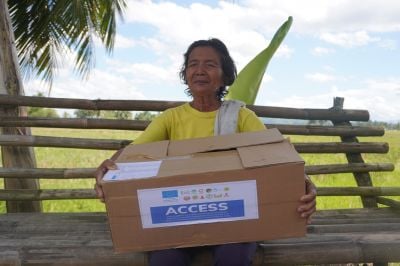They almost died in the floods
It was two years ago, but the nightmare still haunts JD, a 23-year-old man with disabilities. Despite the typhoon warnings, JD and his mother did not evacuate. Their house was soon flooded and, when they eventually attempted to flee, he and his mother nearly drowned.
As the water in their house reached their waists, JD and his mother had to make a break for it, his mother carrying JD on her back. To reach the main road, they had to cross a wooden bridge, but the river had burst its banks and the bridge was barely visible. JD and his mother missed it and fell into the water. Fortunately, his brother was able to grab hold of their mother's clothes and pull them out. Meanwhile, their home was completely destroyed by the flood.
Today, JD and his mother understand the importance of pre-emptive evacuation. They no longer wait for heavy rains or floods to evacuate. So, in last February’s floods, that’s what they did.
Although safe, JD and his mother were among the farmers who lost all their crops in the floods that hit the Mindanao region in February. This region is particularly vulnerable to climate disasters such as floods, which are getting worse every year. As well as being geographically exposed, Mindanao is a very poor region, which increases the vulnerability of its inhabitants.

Nanay Policarpia also lost everything in February’s floods. Nanay is a 69-year-old farmer who lost her sight after a road accident in 2018. Determined to continue working in the fields, Nanay Policarpia now manages to get to the rice fields and plant her crops by herself. When the floods hit her region last February, Nanay really thought she was going to die.
"I had no idea what was going on. I felt useless because I couldn't do anything to support or protect my family," Nanay Policarpia recalls.
Despite having water up to their chests, Nanay Policarpia and her family were not evacuated. She says that the designated evacuation center was too far from her home.
"The heavy rains wiped out months of hard work, and all our capital.”
They were supposed to harvest their crops last April. June was supposed to be a new planting season.
"We had no choice but to borrow again to buy seedlings to plant," Nanay tells us despondently.
Nanay Policarpia is one of the participants in HI's ACCESS project in the Philippines.
"We are very grateful that ACCESS came close to our home instead of us having to go to the distribution site”.
More than 130 million people affected in the last 30 years
The Philippines is regularly hit by typhoons. More than 130 million people have been affected in the last 30 years. In a 2018 study by the Harvard Humanitarian Initiative, more than 75% of Filipinos declared that they had been affected by heavy rains, tropical cyclones, floods and earthquakes over a five-year period. In the same study, almost half of respondents said their home had been damaged by a natural disaster.
In 2024, weather conditions have been exacerbated by the El Niño climate phenomenon, one of the five most powerful climate events ever recorded, according to the World Meteorological Organization. El Niño is a natural process that, when combined with human activity, leads to a sharp rise in temperatures, as is currently the case in Southeast Asia.
While middle-class residents become more resilient and adapt their lifestyles and especially their buildings, the groups facing the most barriers, such as people with disabilities, and older people, find it harder and are the first to suffer.
HI works with vulnerable communities before, during and after emergencies
HI's priority is to empower isolated people, pregnant women and people with disabilities, to prepare for and protect themselves from these disasters, which are extremely common in the Philippines, and to ensure that they are not forgotten by post-disaster relief agencies.
Through its LEAD project, HI helps to raise awareness and directly prepare the most vulnerable families in communities for disasters.
Alma owns a flower shop and has four children. As her house is located near the river, she has been a regular victim of flooding:
"We live with this threat all the time. We know people who have died because they didn't evacuate or didn't listen to the announcements", she tells us.
Physically disabled since the age of 7, Alma took part in HI's disaster preparedness sessions. It was a real wake-up call for this young mother.
"I realized that as a person with a disability, I too could save lives," she says proudly.
Alma is now one of the project's "ambassadors" and has decided to help prepare her whole community for disasters.
"A person with disabilities like me has a real role to play! If only we were consulted and involved in my town's planning and activities, no one would be left behind in an emergency."




